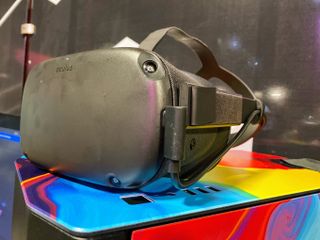Oculus Link hands-on and five questions answered

Of the many things Oculus announced during its annual developer conference, one of the more interesting was Oculus Link. This feature, which is expected to start as a Beta in November, allows you to connect a USB-C cable from the headset to your gaming PC so you can play Oculus Rift S games on your Standalone VR headset.
As features go, this is a bombshell. Oculus Rift S and Oculus Quest launched on the same day, and the general thought was you'd get one if you wanted high end PC-class VR experiences and the other if you wanted a truly portable VR platform with Six Degrees of Freedom in movement for controllers and the headset. Both headsets are incredible, but with Oculus Link it kind of sounds like you only need one right?
I spent some time with Oculus Link here at Oculus Connect 6, and got some answers to the burning questions many have about this crazy new feature.
Does this actually work, or is there a bunch of latency?

Yeah, this really works. In my demo, there was a USB-C cable already connected to the headset and the Oculus app was running on a gaming PC. When I put the headset on, I saw the Oculus Quest UI with the option to choose Oculus Quest titles from the library. However, when I heard the mouse click on the other side of the room, the Oculus Rift S title Asgard's Wrath started loading.
When the game loaded, it felt like I was in a Rift S. The controllers in my hand were suddenly more detailed, and the game I was standing in was absolutely not the experience you get from a normal Quest title. As I moved around, picking up anything I could find to throw and see how natural it felt, I couldn't really pick up on any additional latency. This demo is set up under ideal conditions, and Oculus wasn't sharing what the hardware in that gaming PC was, but the latency difference was imperceptible for me.
Related: Hand tracking on Oculus Quest is absolutely brilliant
What about graphics quality? Does it really look like a Rift S?

It looks as close to a Rift S as you can get when the hardware you're using is measurably less than the Rift S. The display isn't as dense and the lenses aren't as good on Quest, so you still have some small Screen Door Effect and God Rays that you wouldn't usually experience on Rift S. That having been said, when you look through those things it's damned close. I've played Asgard's Wrath twice on a Rift S before today, and this felt close to those other experiences.
Be an expert in 5 minutes
Get the latest news from Android Central, your trusted companion in the world of Android
Oculus is doing a lot of trickery to make this work. During a session explaining the mechanics of this transition, it was made clear Oculus Link deploys a unique set of custom graphics pipelines to make all of this happen. The encode/decode for everything happens in slices instead of the individual frame all at once, and during that encoding there's a distortion curve applied to the outer edges of the image, so most of the quality loss is happening where your eyes are least likely to be looking. It's never going to be 100% the same experience as a Rift S, but the amount of work Oculus is putting into making this happen in a way that isn't off-putting is significant.
Do I really need the special Oculus Link cable?

Not at all. Oculus has repeatedly said you can use any USB-C 3.0 cable and this will work. In fact, when the Beta for Link opens in November, you'll need to supply your own cable to test it out anyway.
Oculus made this cable because it had trouble sourcing a 5-meter cable that didn't have quality or weight issues, and that length was important for a tethered experience to still feel like you had lots of mobility. However, to make it all work, Oculus made its own Fiber Optic cable to meet all of the specifications it had for this experience.
Fiber Optic? Does the Oculus Link cable still charge the headset?

It does! During the demo today the headset charging light was constantly lit, and the battery in the headset claimed to be charging. As near as I can tell, this cable is also keeping the headset fully charged.
But it's also worth pointing out the cable I saw and used today is not the final design, so there may be changed made when the cable moves from Industrial Design to final product. It seems very unlikely that charging would be something sacrificed though.
How much will the cable cost?

A previous version of this article didn't have a price yet, and instead just speculation. We now know, however, this cable is going to be a whopping $79 when it is available to purchase.
And to make things slightly more complicated, fiber optic cables are notoriously fragile. If you regularly run over your normal Oculus Rift cable with your chair, there's a good chance you're going to end up buying more than one of these cables.
In the end, the cable might not be worth it, but the experience it provides might be.

